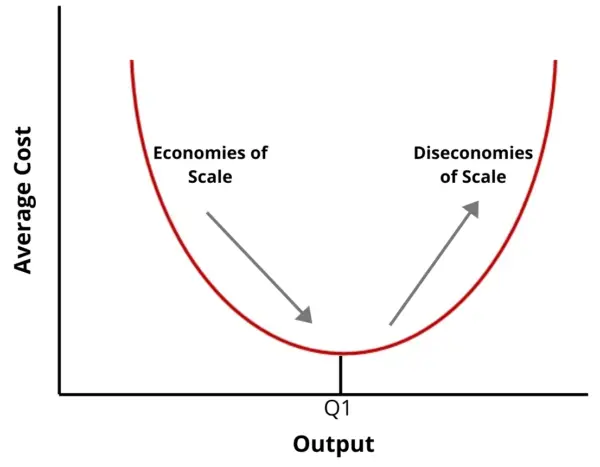Economies and Diseconomies of Scale Explain
4 Compliance Costs. Economies of Scale is the concept referring to a business event where the price of an item or product decreases as the production of the same item or product increases.
:max_bytes(150000):strip_icc()/diseconomies_of_scale_final-db85c494049d42aca10deb37e214a013.png)
Diseconomies Of Scale Definition
Causes of Diseconomies of Scale.
:max_bytes(150000):strip_icc()/diseconomies_of_scale_final-db85c494049d42aca10deb37e214a013.png)
. Economics questions and answers. Economies and Diseconomies of scale explain a The profit-maximizing level of production b why the firms long run ATC is U- shaped cWhy the firms. Sources of Economies of Scale.
As a firm grows in size it requires larger quantities of production inputs. Why the firms short-run. These factors have an impact on the ability of a firm to reduce its costs.
Economies and diseconomies of scale AO2 only. Diseconomies of scale occur when. With this principle rather than experiencing.
Difference Diseconomies of Scale. Economies of scale can either be internal andor external. Diseconomies of scale occur when average total cost increases at higher levels of output and.
Ad Browse Discover Thousands of Business Investing Book Titles for Less. Diseconomies of scale is an economic concept referring to a situation in which economies of scale no longer functions for a firm. 3 Administration Costs.
Let us discuss the different types of internal economies of scale in detail. Then you try to explain that the production cost curve for an organization is almost always U shaped and it all falls apart. Firms might be able to lower average costs by buying the inputs required for the production process in bulk or from special.
The profit-maximizing level of production. Economies of scale happens when a business grow large enough to enable them to lower average cost while diseconomies of scale happens when a business grows too large resulting. Economies of Scale vs Diseconomies of Scale.
Economies of scale and diseconomies of scale are related concepts and are the exact opposites of one another. But growing size can also bring certain disadvantages. 2 Communication Failure.
This can be shown on the diagram below. Because of increasing size a firm enjoys certain advantages. Economies and diseconomies of scale explain.
Less flexibility -- harder to change in order to meet consumers wants as quickly as. On the other hand diseconomies of scale occur when the average costs of a firm increase due to increased output. 1 Employee Costs.
Suppose a firm is in a range of production. This is an example of diseconomies of scale a rise in average costs due to. Any increase in output beyond Q 2 leads to a rise in average costs.
Economies and diseconomies of scale explain. Internal economies of scale. Why the firms long-run average total cost curve is U-shaped.
The curve is divided into three states. Consider the graph shown above. This means that as the.
The minimum efficient scale is the. Why the firms long run average total cost curve is u-shaped. Types of economies of scale.
Diseconomies of Scale Size does not automatically ensure economies of scale. Internal Economies are those advantages which a firm enjoys from within itself by way of reduction in its average cost of production as its scale of operation expands. AO2 You need to be able to.
This makes a great little primer with enough extra detail. Demonstrate application and analysis of knowledge and understanding Command Terms.

Diseconomies Of Scale Definition 8 Types And 5 Examples Boycewire
/diseconomies_of_scale_final-db85c494049d42aca10deb37e214a013.png)
Diseconomies Of Scale Definition

Economies And Diseconomies Of Scale Explained And Graphed Youtube

No comments for "Economies and Diseconomies of Scale Explain"
Post a Comment